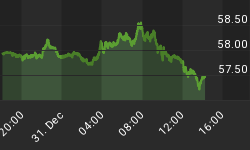Another day of selloff in the bond market, and I wonder how much fingernail-chewing is happening at the Fed? 10-year Treasury yields rose to 3.27% for the first time since mid-June (see Chart). Forget QE2 at the beginning of November, or the discussion about it at the end of August; in June we had just watched volatility spike and the S&P was undecided about whether to go above 1100 or below 1050 (it eventually did both). Inflation expectations were in retreat.

This is starting to get ugly.
The sharp selloff in bonds is, at some level, not terribly surprising because of the time of year. Illiquidity in December is hardly a news flash, and I always take care to remind people that illiquidity doesn't mix well with all of the mortgage paper out there that represents "short gamma" positions. More succinctly put, if you start a stone rolling at this time of year, it is often more likely to gather speed than come to rest.
For all of the beating that nominal yields have taken, though, real yields today got it worse. The 10-year real yield surpassed 1% for the first time since September, on a 19bp selloff. 10-year TIPS yields have risen from 0.40% to 1.04% since the Fed started QE2 (see Chart). Keep in mind that this happened on a day in which the Federal Reserve was buying TIPS in the market.

The movement is largely in real yields...the Fed appears to be winning!
Consider the implication that most of the rise in nominal yields has come from the annihilation of inflation-indexed bonds. Observers will want to say that the bond market vigilantes are punishing a profligate Fed, but that is not at all the case. Yields are jumping because growth expectations are soaring. Bernkanke has them snowed, in other words. He has saved the world, and now we're going to get strong growth and low inflation. Or so the bond market is telling us. No wonder stocks are doing so well!
It's probably a good idea to put this big rise in yields in perspective. While I think the convincing rejection of any attempt at new lows below the Dec-2008 lows is confirmation that the secular decline in interest rates is indeed history (as I said in early 2009), that doesn't mean that a secular rise in rates is necessarily imminent. The chart below plots 10-year Treasury yields back to 1980 (I used to do this on Excel because the axis needs to be logarithmic, but now Bloomberg makes the pictures so much prettier).

In the long sweep of time, we're only half-swept.
The big selloff is in context here, in two opposite senses. On the one hand, even though the selloff is "only" 90bps or so, in relative magnitude that is comparable to the roughly 3% selloff from 7.20% in March 1987 to around 10% in October 1987 (I don't remember what happened next). So 90bps is a big move, in the context of ultra-low rates (and concomitantly long durations).
On the other hand, in the grand scheme of things the selloff only puts yields back in the middle of the secular downtrend. In order to get seriously concerned that a movement significantly higher in rates is about to occur, you'd need to break above 4% or so I think, and confirmation that the secular downtrend is in fact over won't happen until we have a monthly settle above the upper channel line at around 4.40%.
So panic, but take your time.
I wonder, though, what will happen if Initial Claims tomorrow (Consensus: 425k from 436k) continues the recent trend of improvement. Let's be clear: the best information that we have on the jobs market, in the form of Employment, the ADP report, and the Consumer Confidence Jobs Hard to Get number, are clearly indicating that the jobs market is still comatose. The Initial Claims data has been stronger recently, and this may be an early sign of improvement elsewhere since employers need to stop firing so many people before they start hiring. But if that was really happening, I would expect to see something upbeat from the answers of the man-on-the-street. We need to keep in mind that Claims in December and even more in January are difficult to seasonally adjust because lots of people are coming and going from the retail establishments. This is especially true at a time when the gross size of payrolls has already shrunk so dramatically. With all that said, if we do get a below-consensus number tomorrow then I'll take it as reasonable evidence that we can reject the null hypothesis that the underlying run rate of Claims is 445-480k.
So far, though, I think economists are looking too much at the improvement from the 500k print from August (see Chart). Sure, 425k from 500k looks like a trend, but the 500k number wasn't any more real than the 427k dip from early July. The "trend," if you want to call it that, is from an average around 455k, so I think people are getting enthusiastic about false optics.

The improvement from the previous range is still pretty feeble.
The improvement from the local peak is what has economist (too) excited.
That being said - if the Labor Department were to toss out, say, a 410k figure then the bond market doesn't have many people waiting around to catch that knife. Initial Claims isn't something I ordinarily get very excited about, but these days it's worth keeping an eye on.
















